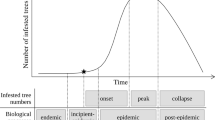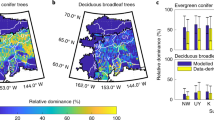Abstract
The mountain pine beetle (Dendroctonus ponderosae Hopkins, Coleoptera: Curculionidae, Scolytinae) is a native insect of the pine forests of western North America, and its populations periodically erupt into large-scale outbreaks1,2,3. During outbreaks, the resulting widespread tree mortality reduces forest carbon uptake and increases future emissions from the decay of killed trees. The impacts of insects on forest carbon dynamics, however, are generally ignored in large-scale modelling analyses. The current outbreak in British Columbia, Canada, is an order of magnitude larger in area and severity than all previous recorded outbreaks4. Here we estimate that the cumulative impact of the beetle outbreak in the affected region during 2000–2020 will be 270 megatonnes (Mt) carbon (or 36 g carbon m-2 yr-1 on average over 374,000 km2 of forest). This impact converted the forest from a small net carbon sink to a large net carbon source both during and immediately after the outbreak. In the worst year, the impacts resulting from the beetle outbreak in British Columbia were equivalent to ∼75% of the average annual direct forest fire emissions from all of Canada during 1959–1999. The resulting reduction in net primary production was of similar magnitude to increases observed during the 1980s and 1990s as a result of global change5. Climate change has contributed to the unprecedented extent and severity of this outbreak6. Insect outbreaks such as this represent an important mechanism by which climate change may undermine the ability of northern forests to take up and store atmospheric carbon, and such impacts should be accounted for in large-scale modelling analyses.
This is a preview of subscription content, access via your institution
Access options
Subscribe to this journal
Receive 51 print issues and online access
$199.00 per year
only $3.90 per issue
Buy this article
- Purchase on Springer Link
- Instant access to full article PDF
Prices may be subject to local taxes which are calculated during checkout




Similar content being viewed by others
References
Amman, G. D. & Cole, W. E. in Mountain Pine Beetle Dynamics in Lodgepole Pine Forests Part II: Population Dynamics. General Technical Report No. GTR-INT-145 (United States Department of Agriculture Forest Service, Intermountain Forest and Range Experiment Station, Ogden, 1983)
Safranyik, L., Shrimpton, D. & Whitney, H. in Management of Lodgepole Pine to Reduce Losses from the Mountain Pine Beetle. Technical Report 1 (Environment Canada, Canadian Forestry Service, Victoria, 1974)
Taylor, S. W. & Carroll, A. L. in Mountain Pine Beetle Symposium: Challenges and Solutions BC-X-399 (eds Shore, T. L., Brooks, J. E. & Stone, J. E.) 41–51 (Natural Resources Canada, Canadian Forest Service, Victoria, 2004)
Taylor, S. W., Carroll, A. L., Alfaro, R. I. & Safranyik, L. in The Mountain Pine Beetle: A Synthesis of Biology, Management and Impacts in Lodgepole Pine (eds Safranyik, L. & Wilson, B.) 67–94 (Natural Resources Canada, Canadian Forest Service, Victoria, 2006)
Nemani, R. R. et al. Climate-driven increases in global terrestrial net primary production from 1982 to 1999. Science 300, 1560–1563 (2003)
Carroll, A. L., Taylor, S. W., Regniere, J. & Safranyik, L. in Mountain Pine Beetle Symposium: Challenges and Solutions. Report number BC-X-399 (eds Shore, T. L., Brooks, J. E. & Stone, J. E.) 223–232 (Natural Resources Canada, Canadian Forest Service, Victoria, 2004)
Mattson, W. J. & Addy, N. D. Phytophagous insects as regulators of forest primary productivity. Science 190, 515–522 (1975)
Parkins, J. R. & McKendrick, N. A. Assessing community vulnerability: a study of the mountain pine beetle outbreak in British Columbia, Canada. Glob. Environ. Chang. 17, 460–471 (2007)
Volney, W. J. A. & Fleming, R. A. Climate change and impacts of boreal forest insects. Agr. Ecosys. Env. 82, 283–294 (2000)
Williams, D. W. & Liebhold, A. M. Climate change and the outbreak ranges of two North American bark beetles. Agr. For. Ent. 4, 87–99 (2002)
Westfall, J. 2006 Summary of Forest Health Conditions in British Columbia (British Columbia Ministry of Forests and Range, Victoria, 2007)
Walton, A. et al. Provincial-Level Projection of the Current Mountain Pine Beetle Outbreak 〈http://www.for.gov.bc.ca/hre/bcmpb/Year4.htm〉 (British Columbia, Ministry of Forest and Range, Victoria, 2007)
Environment Canada. National Inventory Report, 1990–2005: Greenhouse Gas Sources and Sinks in Canada. 〈http://www.ec.gc.ca/pdb/ghg/inventory_report/2005_report/tdm-toc_eng.cfm〉. (Environment Canada, Gatineau, 2007)
Hamann, A. & Wang, T. Potential effects of climate change on ecosystem and tree species distribution in British Columbia. Ecology 87, 2773–2786 (2006)
Amiro, B. D. et al. Direct carbon emissions from Canadian forest fires, 1959–1999. Can. J. For. Res. 31, 512–525 (2001)
Canadell, J. G. et al. in Terrestrial Ecosystems in a Changing World (eds Canadell, J. G., Pataki, D. E. & Pitkelka, L. F.) 59–78 (Springer, Berlin, 2007)
Denman, K. L. et al. in Climate Change 2007: The Physical Science Basis. Contribution of Working Group I to the Fourth Assessment Report of the Intergovernmental Panel on Climate Change (eds Solomon, S. et al.) 499–587 (Cambridge Univ. Press, Cambridge, 2007)
Ayres, M. P. & Lombardero, M. J. Assessing the consequences of global change for forest disturbance from herbivores and pathogens. Sci. Total Environ. 262, 263–286 (2000)
Kurz, W. A., Apps, M. J., Stocks, B. J. & Volney, W. J. A. in Biotic Feedbacks in the Global Climatic System: Will the Warming Feed the Warming? (eds Woodwell, G. M. & Mackenzie, F. T.) 119–133 (Oxford Univ. Press, Oxford, 1995)
Berg, E. E., Henry, J. D., Fastie, C. L., De Volder, A. D. & Matsuoka, S. M. Spruce beetle outbreaks on the Kenai Peninsula, Alaska, and Kluane National Park and Reserve, Yukon Territory: relationship to summer temperatures and regional differences in disturbance regimes. For. Ecol. Manage. 227, 219–232 (2006)
Logan, J. A. & Powell, J. A. Ghost forests, global warming, and the mountain pine beetle (Coleoptera: Scolytidae). Am. Ent. 47, 160–173 (2001)
McGuire, A. D. et al. Carbon balance of the terrestrial biosphere in the twentieth century: analyses of CO2, climate and land use effects with four process-based ecosystem models. G. Biogeoch. Cycles 15, 183–206 (2001)
Myneni, R. B. et al. A large carbon sink in the woody biomass of northern forests. Proc. Nat. Acad. Sci. 98, 14784–14789 (2001)
Wulder, M. A., Dymond, C. C., White, J. C., Leckie, D. G. & Carroll, A. L. Surveying mountain pine beetle damage of forests: a review of remote sensing opportunities. For. Ecol. Manage. 221, 27–41 (2001)
Berryman, A. A. Dynamics of Forest Insect Populations: Patterns, Causes, Implications (Plenum, New York, 1988)
Bond-Lamberty, B., Peckham, S. D., Ahl, D. E. & Gower, S. T. Fire as the dominant driver of central Canadian boreal forest carbon balance. Nature 450, 89–92 (2007)
Kurz, W. A., Stinson, G. & Rampley, G. Could increased boreal forest ecosystem productivity offset carbon losses from increased disturbances? Phil. Trans. R. Soc. B. doi: 10.1098/rstb.2007.2198 (2007)
Kurz, W. A., Apps, M. J., Webb, T. M. & McNamee, P. J. The Carbon Budget of the Canadian Forest Sector: Phase I. Information Report NOR-X-326 (Forestry Canada, Northwest Region, Northern Forestry Centre, Edmonton, 1992)
Kurz, W. A. & Apps, M. J. A 70-year retrospective analysis of carbon fluxes in the Canadian forest sector. Ecol. Appl. 9, 526–547 (1999)
Kull, S. et al. Operational-Scale Carbon Budget Model of the Canadian Forest Sector (CBM-CFS3) Version 1.0: User’s Guide (Natural Resources Canada, Canadian Forest Service, Edmonton, 2006)
Acknowledgements
Funding for this study was provided by Canada’s Climate Change Action Plan. We thank British Columbia Ministry of Forests and Range (MoFR) collaborators for providing data and detailed reviews: D. Draper, G. Lawrence, M. Boyce and D. Spittlehouse. S. Beukema provided assistance in formatting MoFR data for use in CBM-CFS3. Fire and beetle projection methodologies were developed with the assistance of J. Metsaranta, S. Beukema, B. Stocks, B. Amiro, M. Flannigan, R. Landry, B. de Groot, K. Anderson, S. Taylor and T. Shore. Climate data were provided by D. McKenney. CBM-CFS3 model development was assisted by T. White, G. Zhang, M. Magnan, E. Banfield, C. Shaw and B. Simpson. Finally, we thank V. Nealis, D. Draper, D. Spittlehouse and A. Nussbaum for comments on an earlier draft.
Author Contributions All authors contributed to study design, model parameterizations, and development of future projections; C.C.D., G.J.R., G.S. and E.T.N. conducted model simulations; W.A.K., C.C.D., G.S. and E.T.N. analysed results; and all authors contributed to the manuscript.
Author information
Authors and Affiliations
Corresponding author
Supplementary information
Supplementary informaation
The file contains Supplementary Notes, Supplementary Tables S1-S7, Supplementary Figures S1-S5 with Legends and additional references. (PDF 695 kb)
Rights and permissions
About this article
Cite this article
Kurz, W., Dymond, C., Stinson, G. et al. Mountain pine beetle and forest carbon feedback to climate change. Nature 452, 987–990 (2008). https://doi.org/10.1038/nature06777
Received:
Accepted:
Issue Date:
DOI: https://doi.org/10.1038/nature06777
This article is cited by
-
Host-specific growth responses of Larix kaempferi and Quercus acutissima to Asian gypsy moth defoliation in central Korea
Scientific Reports (2024)
-
Forest microbiome and global change
Nature Reviews Microbiology (2023)
-
Pest scenario of Helicoverpa armigera (Hub.) on pigeonpea during future climate change periods under RCP based projections in India
Scientific Reports (2023)
-
Integrating terrestrial and aquatic ecosystems to constrain estimates of land-atmosphere carbon exchange
Nature Communications (2023)
-
Northern expansion is not compensating for southern declines in North American boreal forests
Nature Communications (2023)
Comments
By submitting a comment you agree to abide by our Terms and Community Guidelines. If you find something abusive or that does not comply with our terms or guidelines please flag it as inappropriate.



